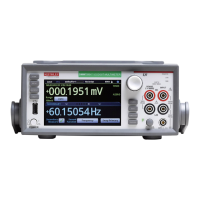el DMM7510 7½ Digit Graphical Sampling Multimeter Reference Manual Section 2:
DMM7510-901-01 Rev. B / May 2015 2-145
7. Select the type of waveform:
Edge: The trigger event occurs when the signal crosses a certain level.
Pulse: The trigger event occurs when a pulse satisfies the amplitude, polarity, and pulse
width requirements that you specify.
Window: The trigger event occurs when the signal enters or exits a window that is defined by
low and high signal levels.
8. Set the length of the Delay that occurs before each measurement. 0 sets no delay.
9. Set the Position. The position marks the location in the reading buffer where the trigger will
occur. The position is set as a percentage of the active buffer capacity. The buffer captures
measurements until a trigger occurs. When the trigger occurs, the buffer retains the percentage of
readings specified by the position, then captures remaining readings until 100 percent of the
buffer is filled.
10. Set the Trigger Clear behavior. Select Enter to clear previously detected trigger events when
entering the wait block; select Never to immediately act on any previously detected triggers and
not clear them.
11. Turn High Frequency Rejection On or Off as needed.
12. See the following procedures to set the remaining settings for the type of waveform.
If you have a fast cyclic signal, the trigger may occur before the instrument can gather sufficient
pretrigger data. If this occurs, you will see less pretrigger data than expected. However, the correct
amount of posttrigger data will be collected.
Select the options for the Edge waveform:
1. Set the Level to the signal level that generates the trigger event.
2. Set the Slope to rising or falling. Rising causes a trigger event when the analog signal trends
from below the analog signal level to above the level. Falling causes a trigger event when the
signal trends from above to below the level.
3. To start the measurements, select the Trigger Mode Indicator at the upper right of the screen and
select Initiate Trigger Model. The trigger model waits for an edge that meets the criteria.
Select the options for the Pulse waveform:
1. Set the Level to the pulse level that generates the trigger event.
2. Set the Condition to Greater or Less. This defines if the pulse must be greater than or less than
the pulse width before an analog trigger is generated.
3. Set the Polarity to Above Level or Below Level. This determines if the trigger occurs when the
pulse is above the defined signal level or below the defined signal level.
4. Set the Pulse Width. This sets pulse width that generates a trigger event.
5. To start the measurements, select the Trigger Mode Indicator at the upper right of the screen and
select Initiate Trigger Model. The trigger model waits for a pulse that meets the criteria.
Select the options for the Window waveform:
1. Set the Low Boundary value of the window.
2. Set the High Boundary value of the window.
3. Set the Direction. Select Entering if the analog trigger occurs when the signal enters the window
defined by the boundaries. Select Leaving if the analog trigger occurs when the signal leaves the
window.
4. To start the measurements, select the Trigger Mode Indicator at the upper right of the screen and
select Initiate Trigger Model. The trigger model waits for a signal that meets the criteria.

